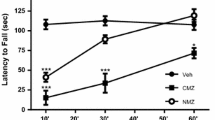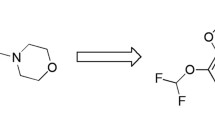Abstract
MHP-133 is one of a novel series of compounds designed to target multiple brain substrates expected to have synergistic actions in the treatment of cognitive and neurodegenerative disorders such as Alzheimer’s disease. The strategy was to develop compounds with multiple targets relevant for enhancing cognition and memory, but avoiding the serious side effects attributed to high potency cholinergic agonists. MHP-133 was shown to interact with subtypes of cholinergic, serotonergic, and imidazoline receptors and to weakly inhibit acetylcholinesterase activity. In vitro, the drug enhanced nerve growth factor (TrkA) receptor expression; it prevented excitotoxicity in a hippocampal slice preparation; and increased the secretion of soluble (non-toxic) amyloid precursor protein. MHP-133 also enhanced cognitive performance by rats and by non-human primate in tasks designed to assess working memory. The results of this study are consistent with the potential use of MHP-133 in the treatment of neurodegenerative disorders such as Alzheimer’s disease.








Similar content being viewed by others
References
Morris JC, McKeel DW Jr, Storandt M, Rubin EH, Price JL, Grant EA, Ball MJ, Berg L (1991) Very mild Alzheimer’s disease: informant based clinical, psychometric, and pathologic distinction from normal aging. Neurology 41:469–478
Lockhart BP, Lestage PJ (2003) Cognition enhancing or neuroprotective compounds for the treatment of cognitive disorders: why? when? which? Exp Gerontol 38:119–128
Levey A, Lah J, Goldstein F, Steenland K, Bliwise D (2006) Mild cognitive impairment: an opportunity to identify patients at high risk for progression to Alzheimer’s disease. Clin Therapeut 28:991–1001
Francis PT, Palmer AM, Snape M, Wilcock GK (1999) The cholinergic hypothesis of Alzheimer’s disease: a review of progress. J Neurol Neurosurg Psychiatry 66:137–147
Terry AV, Jr. Buccafusco JJ (2003) The cholinergic hypothesis of Alzheimer’s disease: recent challenges and their implications for novel drug development. J Pharmacol Exp Ther 306:821–827
Engelborghs S, De Deyn PP (1997) The neurochemistry of Alzheimer’s disease. Acta Neurologica Belgica 97:67–84
Myhrer T (1998) Adverse psychological impact, glutamatergic dysfunction, and risk factors for Alzheimer’s disease. Neurosci Biobehav Rev 23:131–139
Riedel G, Micheau J, Lam AGM, Roloff EVL, Martin SJ, Bridge H, de Hoz L, Poeschel B, McCulloch J, Morris RGM (1999) Reversible neural inactivation reveals hippocampal participation in several memory processes. Nature Neurosci 2:898–905
Elrod K, Buccafusco JJ, Jackson WJ (1988) Nicotine enhances delayed matching-to-sample performance by primates. Life Sci 43:277–287
Buccafusco JJ, Prendergast M, Terry AV, Jr. Jackson WJ (1996) Cognitive effects of nicotinic cholinergic agonists in non-human primates. Drug Development Res 38:196–203
Powers JC, Hernandez MA, Thornton S, Glinski J, May SW (1993) Quartenary pyridinium compounds. U.S. Patent 5:206371
Powers JC, Buccafusco JJ, Starks M (1998) Pyridinium compounds. U.S. Patent 5:714,615
Powers JC, Buccafusco JJ, Starks M (1998) Pyridinium compounds. U.S. Patent 5:726,314
Buccafusco JJ, Jr Terry AV (2000) Multiple CNS targets for eliciting beneficial effects on memory and cognition. J Pharmacol Exp Ther 295:438–446
Starks KM, Ortega-Vilain A-C, Buccafusco JJ, Powers JC (1995) Novel pyridinium derivatives as inhibitors for acetylcholinesterase. J Enzym Inhib 10:27–45
Canney DJ, Zhang M, Doukas PH, Massakowski CJ, Aronstam R, Gattu M, Buccafusco JJ (1998) Characterization of ethyl (3-quinuclidinyl) acetate (EQA) as a ligand for acetylcholine receptors. Life Sci 63:PL 329–PL 336
Lee RK, Wurtman RJ, Cox AJ, Nitsch RM (1995) Amyloid precursor protein processing is stimulated by metabotropic glutamate receptors. Proc Nat Acad Sci USA 92:8083–8087
Stoppini L, Buchs PA, Muller D (1991) A simple method for organotypic cultures of nervous tissue. J Neurosci Methods 37:173–182
Mulholland PJ, Prendergast MA (2002) Post-insult exposure to (+/−) kavain potentiates N-methyl-D-aspartate toxicity in the developing hippocampus. Brain Res 945:106–113
Jonnala RR, Terry. AV, Jr. Buccafusco JJ (2002) Nicotine increases the expression of high affinity nerve growth factor receptors both in vitro and in vivo. Life Sci 70:1543–1554
Dunn MA, Sidell FR (1989) Progress in medical defense against nerve agents. JAMA 262:649–652
Albuquerque EX, Aracava Y, Cintra WM, Brossi A, Schonenberger B, Deshpande SS (1988) Structure-activity relationship of reversible cholinesterase inhibitors: activation, channel blockade and stereospecificity of the nicotinic acetylcholine receptor-ion channel complex. Braz J Med Biolog Res 21:1173–1196
Rowell P (2002) Effects of nicotine on dopaminergic neurotransmission. In: Levin ED (ed) Nicotinic receptors in the nervous system, CRC Press, New York, pp 51–80
Buccafusco JJ, Jr. Terry AV (2002) Nicotine and cognition in young and aged nonhuman primates. In: Levin ED (ed) Nicotinic receptors in the nervous system, CRC Press, New York, pp 179–197
Buccafusco JJ (2004) Neuronal nicotinic receptor subtypes: defining therapeutic targets. Mol Intervent 4:285–295
Buccafusco JJ, Letchworth SR, Bencherif M, Lippillo PM (2005) Long-lasting cognitive improvement with nicotinic receptor agonists: mechanisms of pharmacokinetic-pharmacodynamic discordance. Trends Pharmacolog Sci 26:352–360
Giacobini E (2004) Drugs that target cholinesterses. In: Buccafusco JJ (ed) Cognitive enhancing drugs, Birkhäuser Verlag, Basel, pp 11–36
Terry AV, Jr. Buccafusco JJ, Jackson WJ, Prendergast MA, Fontana DJ, Wong EH, Bonhaus DW, Weller P, Eglen RM (1998) Enhanced delayed matching performance in younger and older macaques administered the 5-HT4 receptor agonist, RS 17017. Psychopharmacology 135:407–415
Eglan RM, Wong EHF, Dumuis A, Bockaert J (1995) Central 5HT4 receptors. Trends Pharmacolog Sci 16:391–398
Picciotto MR, Zoli M (2002) Nicotinic receptors in aging and dementia. J Neurobiol 53:641–655
Quik M, Kulak JM (2002) Nicotine and nicotinic receptors; relevance to Parkinson’s disease. Neurotoxicology 23:581–594
Virginio C, Giacometti A, Aldegheri L, Rimland JM, Terstappen GC (2002). Pharmacological properties of rat alpha 7 nicotinic receptors expressed in native and recombinant cell systems. Eur J Pharmacol 445:153–161
Avila AM, Davila-Garcia MI, Ascarrunz VS, Xiao Y, Kellar KJ (2003). Differential regulation of nicotinic acetylcholine receptors in PC-12 cells by nicotine and nerve growth factor. Mol Pharmacol 64:974–986
Farias GG, Godoy JA, Hernandez F, Avila J, Fisher A, Inestrosa NC (2004) M1 muscarinic receptor activation protects neurons from beta-amyloid toxicity. A role for Wnt signaling pathway. Neurobiol Disease 17:337–348
Yang B, Lin H, Xu C, Liu Y, Wang H, Han H, Wang Z (2005) Choline produces cytoprotective effects against ischemic myocardial injuries: evidence for the role of cardiac m3 subtype muscarinic acetylcholine receptors. Cell Physiol Biochem 16:163–174
Fisher A, Brandeis R, Haring R, Bar-Ner N, Kliger-Spatz M, Natan N, Sonego H, Marcovitch I, Pittel Z (2002) AF150(S) and AF267B. M1 Muscarinic agonists as innovative therapies for Alzheimer’s disease. J Mol Neurosci 19:145–153
Youdim MBH, Buccafusco JJ (2005) CNS targets for multi-functional drugs in the treatment of neurodegenerative diseases. J Neural Transm 112:519–537
Weinreb O, Amit T, Bar-Am O, Sagi Y, Mandel S, Youdim MB (2006) Involvement of multiple survival signal transduction pathways in the neuroprotective, neurorescue and APP processing activity of rasagiline and its propargyl moiety. J Neural Transmission Suppl 70:457–765
Li XD, Arias E, Jonnala RR, Mruthinti S, Buccafusco JJ (2005) Effect of amyloid peptides on the increase in TrkA receptor expression induced by nicotine in vitro and in vivo. J Mol Neurosci 27:325–336
Yogev-Falach M, Bar-Am O, Amit T, Weinreb O, Youdim MB (2006) A multifunctional, neuroprotective drug, ladostigil (TV3326), regulates holo-APP translation and processing. FASEB J 20:2177–2179
Acknowledgments
This work was supported by a grant from the Callaway Foundation of Georgia, by the Medical College of Georgia Alzheimer’s Research Center, and by salary support for JJB from the Veterans Administration Merit Review program. The authors also would like to acknowledge the fine technical assistance provided by Nancy Kille and Laura Shuster. Lastly we would like to thank Professor Moussa B. Youdim for his contributions to the field of novel drug discovery and for many enlightened conversations over the years.
Author information
Authors and Affiliations
Corresponding author
Additional information
Special issue dedicated to Dr. Moussa Youdim.
An erratum to this article can be found at http://dx.doi.org/10.1007/s11064-007-9489-4
Rights and permissions
About this article
Cite this article
Buccafusco, J.J., Powers, J.C., Hernandez, M.A. et al. MHP-133, a Drug with Multiple CNS Targets: Potential for Neuroprotection and Enhanced Cognition. Neurochem Res 32, 1224–1237 (2007). https://doi.org/10.1007/s11064-007-9294-0
Received:
Accepted:
Published:
Issue Date:
DOI: https://doi.org/10.1007/s11064-007-9294-0




